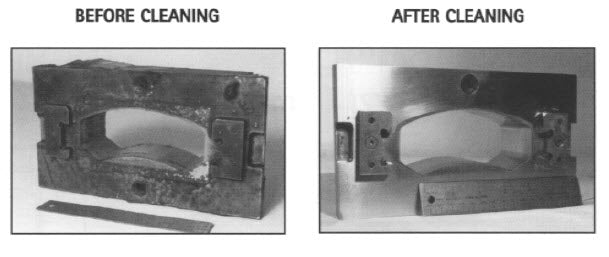Ultrasonic Cleaning of Injection Molds

I would like to get a quote on a two tank IC series unit for cleaning and rinsing molds. The items are approximately 8” high and 3-5” in diameter. There are 36 of the molds that are mounted in the press at one time. The idea would be to clean them either when they are removed or before they are installed in the press. We had a demonstration of a table top unit but it was too small for our purposes. The demonstration confirmed that the parts need to be rinsed after they are cleaned to remove the residue from the cleaning solution mixed with the deposits from the mold. Does that require a second tank?
es.
Can the cleaning solution be drained and the tank refilled with clean water to rinse the parts?
Yes, but that is very time consuming.
Since these are not large items would the 40 kHz unit be the better unit?
Yes – molds usually have some kind of detail, and 40khz is better at cleaning tinier holes, ridges, indents. etc.
We would be putting a number of them in the unit for cleaning at the same time. I don’t know what is considered high density.
- temperature
- ultrasonic frequency
- concentration of cleaning fluid
- time in tank
- time in rinse
- # of parts
- parts orientation
- any other details you believe may be salient to your particular application
Take pictures of part orientation as well. Once you have a recipe for clean parts, try to reduce these variables: time, cleaning fluid concentration, temperature. The idea is work your way towards a plan that gives you parts that meet your specs, while using as few resources and as little time as possible. About your spec: It has to be objective. Not: “well, our current client says they are fine.” More like: “When checked at 10x magnification no particulate residue is seen. A wipe with lint free cloth #15a shows no soil. Inspection under black light shows no remaining petroleum product residue.” Give people numbers – that way when your customers (internal or external) sign off on a spec and you meet it, there is no finger pointing later. Use numbers and specify magnification, etc whenever possible. I used to do a lot of manufacturing system design, and I saw more heartburn because of people not having clear specs and not being EXACTLY sure what was required than for any other reason.
Is the cleaning solution reusable?
You can set up a filter system to remove particulate, and also decant cleaning fluid into a barrel. Let it sit for a couple of days so that petroleum base soils float to the top, then take the fluid out of the bottom. How well this fluid will work depends on both your application and the type and concentration of remaining soils. All cleaning fluids do become “spent” at some point however.
As we see here, properly configuring an ultrasonic cleaning solution is more than just lining up some tanks. Multiple variables need to be considered. If you have a complex cleaning challenge, your best bet is to call someone who understands what is involved.
We have a full line of industrial ultrasonics, ranging from the simple DHA-1000 stand alone unit, to full featured IC series machine – and even S8000 industrial tanks and generators. Call or email us for help setting up your cleaning system.
- Tags: Applications
- Last Updated
- David Huckabay




Comments 0